Function W gives the weight of a dog, in kilograms, when it is y years old. Which statement represents the meaning of the equation W(5) = 27 in this situation?
a. The dog weighs 5 kilograms when it is 27 years old.
b. The dog weighs 27 kilograms when it is 5 years old.
c. The weight of the dog has been 27 kilograms for 5 years.
d. The dog weighs 27 kilograms when it is 5 months old.
The owner of a small restaurant bought 77 kilograms of hamburger meat. Each week, the restaurant uses 5.5 kilograms of hamburger meat. Function H gives the remaining amount of hamburger meat, in kilograms, as a function of the number of weeks (w) since the restaurant owner bought the hamburger meat.
How much meat does the owner have after 3 weeks?
What is 60.5 kilograms?
Functions L and N give the population of Los Angeles and New York, respectively, t years since 2000. In each function, population is measured in millions. Here are the graphs of the two functions.
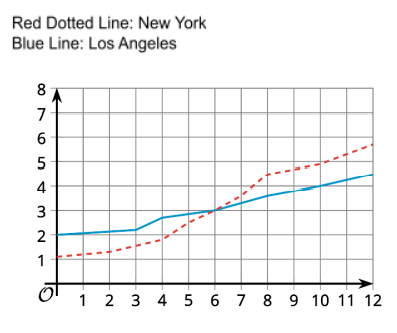 Are there values of t at which the equation L(t)=N(t) is true? If so, which one or which ones?
Are there values of t at which the equation L(t)=N(t) is true? If so, which one or which ones?
What is t=6?
The table and the graph show the population of New Zealand between 2010 and 2015.
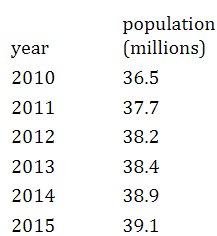
The average rate of population growth between 2012 and 2015 is 0.3 million people per year. If the population continues to grow at this rate, in which year will it reach 41 million?
What is 2022?
Function K gives the amount of snow measured by a snow gauge t hours since it started snowing. The amount of snow is measured in inches.
What does this expression or equation represent in this situation? K(3)
What is the amount of snow after 3 hours?
The owner of a small restaurant bought 77 kilograms of hamburger meat. Each week, the restaurant uses 5.5 kilograms of hamburger meat. Function H gives the remaining amount of hamburger meat, in kilograms, as a function of the number of weeks (w) since the restaurant owner bought the hamburger meat.
How much meat does the owner have after 11 weeks?
What is 16.5 kilograms?
Functions L and N give the population of Los Angeles and New York, respectively, t years since 2000. In each function, population is measured in millions. Here are the graphs of the two functions.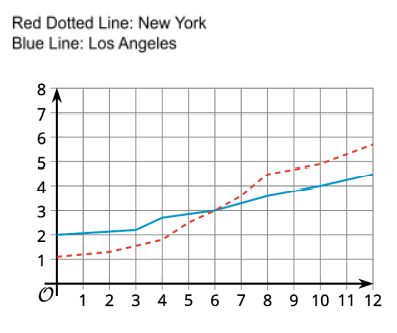 Which function value is greater: L(3) or N(3)?
Which function value is greater: L(3) or N(3)?
What is L(3)?
The table and the graph show the population of New Zealand between 2010 and 2015.

Find the average rate of population growth between 2011 and 2015.
What is 0.35 million people per year?
Function K gives the amount of snow measured by a snow gauge t hours since it started snowing. The amount of snow is measured in inches.
What does the expression or equation represent in this situation? K(0.5) = 2
What is after 30 minutes, there is 2 inches of snow?
The owner of a small restaurant bought 77 kilograms of hamburger meat. Each week, the restaurant uses 5.5 kilograms of hamburger meat. Function H gives the remaining amount of hamburger meat, in kilograms, as a function of the number of weeks (w) since the restaurant owner bought the hamburger meat.
Use function notation to write a rule that defines Function H.
What is H(w)=77-5.5w ?
A frog jumps from a tree limb and hops along the ground. The graph shows the height of the frog over time. Height is measured in meters and time is measured in seconds.
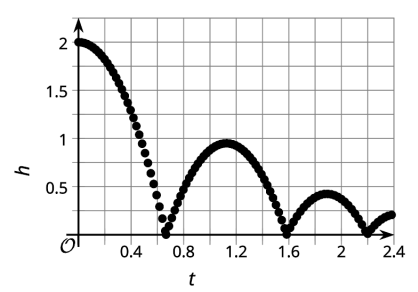
Select all statements that are true about the graph and the situation it represents.
a. The vertical intercept shows the time when the frog lands on the ground.
b. The vertical intercept shows when the frog jumps from the tree branch.
c. The frog reaches its maximum height after its first hop.
d. The frog is at its maximum height at the vertical intercept.
What is b and d?
The table and the graph show the population of New Zealand between 2010 and 2015.

Find the average rate of population growth between 2012 and 2014.
What is 0.35 million people per year?
Function K gives the amount of snow measured by a snow gauge t hours since it started snowing. The amount of snow is measured in inches.
Use function notation to represent the statement: Seven hours after it started snowing, the amount of snow was eight inches.
What is K(7)=8 ?
The owner of a small restaurant bought 77 kilograms of hamburger meat. Each week, the restaurant uses 5.5 kilograms of hamburger meat. Function H gives the remaining amount of hamburger meat, in kilograms, as a function of the number of weeks (w) since the restaurant owner bought the hamburger meat.
Solve the equation H(w)=27.5 and explain what the solution means in this situation.
What is w=9?
Function J gives the distance of a jet ski from the dock t seconds after leaving the dock. Distance is measured in meters. Here is a graph that represents J.
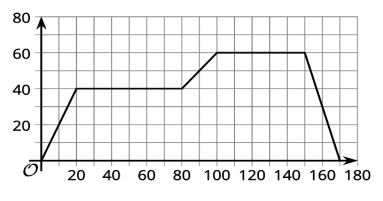
Select all statements in function notation that represent the situation.
a. J(20)=J(40)
b. J(170)=0
c. J(80)>J(100)
What is a and b?
The table and the graph show the population of New Zealand between 2010 and 2015.

How does the average rate of change of the population from 2012 to 2014 compare to that from 2010 to 2012?
What is 2012-2014: 0.35 million and 2010-2012: 0.85 million?
Function K gives the amount of snow measured by a snow gauge t hours since it started snowing. The amount of snow is measured in inches.
Use function notation to represent the statement: The amount of snow 120 minutes after it started snowing was the same as the amount 150 minutes after it started snowing.
What is K(2)=K(2.5) ?
The owner of a small restaurant bought 77 kilograms of hamburger meat. Each week, the restaurant uses 5.5 kilograms of hamburger meat. Function H gives the remaining amount of hamburger meat, in kilograms, as a function of the number of weeks (w) since the restaurant owner bought the hamburger meat.
Explain what the solution to H(w)=27.5 means in this situation.
What is after 9 weeks, the restaurant has 27.5 kg of hamburger meat left?
Function J gives the distance of a jet ski from the dock t seconds after leaving the dock. Distance is measured in meters. Here is a graph that represents J.

Select all statements in function notation that represent the situation.
d. J(t)=0 when is 10.
e. J(170)=0
f. J(0)=180
g. J(100)=60
What is e and g?
The table and the graph show the population of New Zealand between 2010 and 2015.

What does the average rate of change of the population from 2012 to 2014 compared to that from 2010 to 2012 mean in this situation?
What is the population was growing faster between 2010 and 2012 than it was between 2012 and 2014?